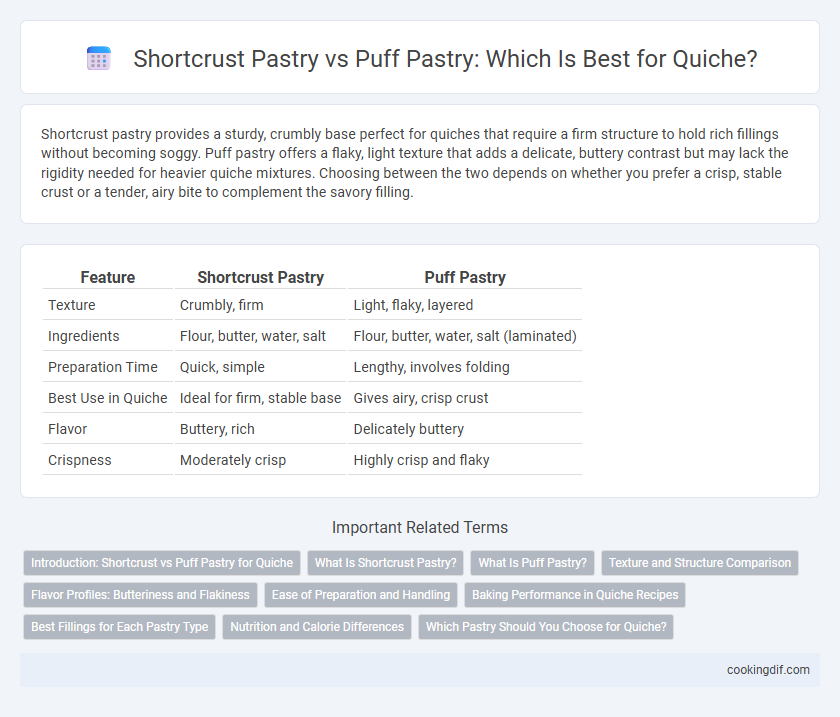Shortcrust pastry provides a sturdy, crumbly base perfect for quiches that require a firm structure to hold rich fillings without becoming soggy. Puff pastry offers a flaky, light texture that adds a delicate, buttery contrast but may lack the rigidity needed for heavier quiche mixtures. Choosing between the two depends on whether you prefer a crisp, stable crust or a tender, airy bite to complement the savory filling.
Table of Comparison
| Feature | Shortcrust Pastry | Puff Pastry |
|---|---|---|
| Texture | Crumbly, firm | Light, flaky, layered |
| Ingredients | Flour, butter, water, salt | Flour, butter, water, salt (laminated) |
| Preparation Time | Quick, simple | Lengthy, involves folding |
| Best Use in Quiche | Ideal for firm, stable base | Gives airy, crisp crust |
| Flavor | Buttery, rich | Delicately buttery |
| Crispness | Moderately crisp | Highly crisp and flaky |
Introduction: Shortcrust vs Puff Pastry for Quiche
Shortcrust pastry offers a crumbly, buttery texture that provides a sturdy base, ideal for supporting rich quiche fillings without becoming soggy. Puff pastry creates a light, flaky, and airy crust that adds a delicate crunch but may be less stable for heavier or wetter quiche ingredients. Choosing between shortcrust and puff pastry depends on whether a firm, crumbly crust or a crisp, layered pastry is preferred for the quiche's overall texture.
What Is Shortcrust Pastry?
Shortcrust pastry is a type of dough made from flour, fat (usually butter), and water, resulting in a crumbly and tender texture ideal for quiche bases. Unlike puff pastry, which relies on multiple layers of dough and butter to create a flaky structure, shortcrust pastry provides a sturdy, non-rising crust perfect for holding creamy quiche fillings. Its simplicity and rich buttery flavor make it a popular choice for savory tarts requiring a firm yet delicate foundation.
What Is Puff Pastry?
Puff pastry is a light, flaky pastry made from layers of dough and butter that rise dramatically when baked, creating a crisp texture ideal for quiche crusts requiring a delicate, airy base. Its laminated structure contrasts with shortcrust pastry, which is denser and crumbly, offering a sturdier and richer foundation for quiches filled with savory ingredients. The choice between puff pastry and shortcrust pastry significantly influences the quiche's texture and mouthfeel, making puff pastry a preferred option for a lighter, flakier quiche shell.
Texture and Structure Comparison
Shortcrust pastry offers a firm, crumbly texture with a dense structure that holds fillings well, making it ideal for quiches requiring a sturdy base. Puff pastry provides a light, flaky texture with multiple crisp layers created by butter laminations, giving quiches a delicate and airy crust. The choice between shortcrust and puff pastry impacts the overall mouthfeel and structural integrity of the quiche.
Flavor Profiles: Butteriness and Flakiness
Shortcrust pastry offers a rich, buttery flavor with a dense, crumbly texture that holds fillings well in quiche. Puff pastry delivers a lighter, flakier texture with multiple airy layers, providing a delicate butteriness that contrasts with the filling. Choosing between the two depends on whether a more substantial bite or a crisp, layered crust is desired for the quiche experience.
Ease of Preparation and Handling
Shortcrust pastry offers ease of preparation with a simple dough that is less sticky, making it straightforward to roll out and shape for quiche bases. Puff pastry requires careful handling to maintain its layered structure, demanding precise temperature control and gentle rolling to prevent the butter from melting. For home cooks seeking convenience, shortcrust pastry is more forgiving and quicker to prepare compared to the delicate and technique-sensitive puff pastry.
Baking Performance in Quiche Recipes
Shortcrust pastry provides a sturdy, crisp base that supports the dense filling of quiche without becoming soggy, ensuring a firm texture and even browning. Puff pastry, with its multiple layers of butter and dough, results in a delicate, flaky crust but can struggle to hold moist fillings, sometimes leading to a less stable quiche structure. For quiche recipes, shortcrust pastry is often preferred for its consistent baking performance and ability to maintain shape under the weight of custard and vegetables.
Best Fillings for Each Pastry Type
Shortcrust pastry pairs best with hearty quiche fillings like spinach and bacon, mushroom and cheese, or classic Lorraine to provide a sturdy, crumbly base that supports rich ingredients. Puff pastry suits lighter, more delicate fillings such as zucchini and goat cheese, smoked salmon with herbs, or asparagus and ricotta, offering a flaky, buttery texture that complements softer components. Choosing the right pastry enhances the quiche's flavor and texture, making the filling's characteristics stand out perfectly.
Nutrition and Calorie Differences
Shortcrust pastry typically contains higher fat content due to the use of butter or lard, resulting in approximately 200-250 calories per 100 grams, whereas puff pastry often exceeds 300 calories per 100 grams because of its multiple layers of butter. Nutritionally, shortcrust pastry offers more protein and fiber when wholemeal flour is used, while puff pastry tends to have a higher saturated fat level due to repeated lamination with butter. For a quiche, choosing shortcrust pastry can provide a more balanced nutrient profile and lower calorie intake, supporting healthier dietary options.
Which Pastry Should You Choose for Quiche?
Shortcrust pastry provides a sturdy, crumbly base that holds up well to the wet filling of quiche, ensuring a crisp texture and rich buttery flavor. Puff pastry offers a lighter, flaky crust with multiple delicate layers that add an airy contrast to the creamy egg custard. For a traditional savory quiche with a firm crust, shortcrust pastry is ideal, while puff pastry suits those seeking a more delicate and flaky finish.
Shortcrust pastry vs puff pastry for quiche Infographic

 cookingdif.com
cookingdif.com